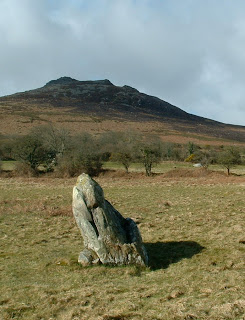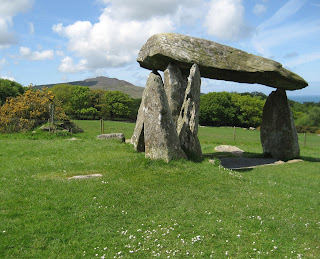I've been mulling over the question of the precise provenancing of the standing stones, stumps and fragments found at Stonehenge. I don't think we sorted this out properly during our previous discussion.
As an amateur geologist who became quite good at the matching up of hand samples but who became completely lost when I sat in on an Oxford University optical mineralogy class, I'm still not sure how close science has brought us to being able to say that fragment A (or thin section A) comes from location B, to an accuracy of maybe 100m. As I understand it, the two methods we have currently for this provenancing are petrography, giving a physical measure of the minerals and their arrangement or "structure" in a thin section, and geochemistry, giving a chemical and hopefully quite unique representation of the number of minerals present and their abundance. The two together should give an accurate "fix" -- and should enable one sample to be compared with another in order to find an identical (or maybe just a close) match.
As I understand it, Rob and Richard have been able to say that the rhyolite at Pont Saeson has a characteristic structure which is altered (by a long process of metamorphism) from the way it looked originally. So far so good. But how big is the area over which that precise degree of alteration of that precise mixture of minerals is recognizeable? Ten metres? A hundred? A kilometre? If the Pont Saeson sample used in the recent work came from the prominent rock outcrop in the valley, and if it was 90% matched with a fragment from Stonehenge, there is obviously a pretty good chance that the fragment came from the outcrop. But is it not possible that there is another locality, somewhere in the yellow area (Fishuard Volcanics) shown on the map where there is a 100% match? The ACTUAL provenance of the fragment might not be a prominent outcrop at all -- indeed it may nowadays be covered with sediments, and may therefore be quite invisible without excavation...........
Three locations where Fishguard Volcanics are exposed --
Brithdir Mawr, Pentre Ifan and the coast near Dinas
What I'm getting at is misplaced confidence. We have all had a good go at Herbert Thomas for his simplified and even simplistic provenancing of the Stonehenge bluestones to Carn Meini and the immediate neighbourhood........ and although huge progress has now been made in both geochemistry and petrography, there is still a margin of error that we must not forget about. How many locations within the yellow area on the map have been sampled with a view of matching the fragment now assigned to Pont Saeson? It would be good to see a map of the sampled points. Maybe that is something that will come in a future publication?
I raise this not because I want to throw any doubt on the excellent and important recent geological work on the bluestones, but because I'm particularly interested in the ENTRAINMENT process. There is no particular reason why bluestone boulders, pillars or pebbles should be entrained from prominent tors like Carn Meini, or from smallish rock outcrops like that in the valley at Pont Saeson. The entrainment of big and small lumps of volcanic ash, rhyolite, ignimbrite and other complicated rocks with unpronounceable names could have occurred anywhere within that area marked yellow, and we should expect that material to show up in the Stonehenge "debitage."
I look forward to seeing the next paper on the next batch of fragments....




14 comments:
Brian,
I sense that you are at the same time assured and troubled with these new geological evidence re:provenance of Stonehenge debitage fragments. Assured because this evidence provides strong argument that the bluestones came from a variety of places not before suspected, and not from one source. Thus favoring glacier transport. Troubled because …? What exactly is it that you want the evidence to show? Or is it that you are overly cautious not to jump to any conclusions and need to pin this issue down to 100% provenance point.
Looking at the map in your post, what is the geomorphology around the yellow area? Can you describe the geomorphology to the north and to the south and east of the yellow area? Can't figure out the elevations and terrain features from this map.
But there is something that you see in all this that is troubling you. Please explain what is troubling you. If nothing is troubling you, than I have some questions that should cause you much trouble! For one, please explain the alluvial characteristics of the Stonehenge Layer and of The Stonehenge Avenue!
Kostas
No, I'm not troubled, Kostas! Not lying awake at night worrying about all of this! Just intrigued......
My main point is that we shouldn't be pulled unwittingly into another situation similar to that of 1921, when it was assumed that the geology was "sorted out" and that Carn Meini was undisputably the source of the Stonehenge bluestones. The progress that the geologists have made recently is fantastic, and I'm intrigued by the suggestions in their publications that there are still many more "unidentified" fragments from Stonehenge yet to be provenanced. This is getting seriously interesting......
I come at this from a glacial geomorphology angle, wondering where the most likely glacial entrainment locations might be.
Brian,
I am pleased that you are not losing any sleep! Happy to hear that you remain restful and clear about Stonehenge … but what about the alluvial characteristics of The Stonehenge Layer and The Stonehenge Avenue? How do you account for this?
Kostas
Your discussion of the glacial ENTRAINMENT process is very relevant to your whole thesis on glaciation.
Unfortunately, it would seem certain other Academics are equally concerned that they should continue their no doubt highly-enjoyable ride on their rather spurious GRAVY TRAIN.
"We are riding on a railroad singing someone else's song...."
JAMES TAYLOR
Kostas -- not sure what you mean by the "alluvial characteristics" -- in any regolith (the broken rock and soil layer close to the ground surface) you get various horizons, some of which may be coarse and some fine, some leached and some with pricipitated material like iron and manganese oxides. i don't see any sign of any "water-lain" layer of the type that Robert seems very keen on!
James -- yes, these dear fellows have had many years of training behind them, and they have spent years in training others as to the merits of the gravy train. As you suggest, they probably won't get off until it hits the buffers.
Brian,
Without going into too great detail, do you agree that The Stonehenge Layer and Avenue have distinct features that set these apart from the surrounding landscape?
If we agree on that point then the question is whether these features are made by men or by nature. There are many good reasons why men did not make these features. And even geologists on the field attest to these being more likely natural.
So my question to you is what geological/geomorphological processes would make the Layer and Avenue distinct from the surrounding grounds? My theory can explain this!
Kostas
Without a vast network of holes and trenches across the landscape, I don't think we can say that Stonehenge and the Avenue have "different" soil horizons from those found everywhere else. Obviously in and around a monument or archaeological site you will find debris or even layers which represent certain phases -- that is what archaeological digs tend to concentrate on. But without a full three-dimensional picture of the extent and interdigitisation of natural and man-made layers we don't know how extensive the traces of human interference may be. So where are you going on this, Kostas? I don't follow you....
Brian,
I agree that there is a need for much field research on Stonehenge. So I wont belabor the point. But to take this questions away from the controversy surrounding Stonehenge...
What geological processes will leave behind a circular layer which is distinct from the surrounding landscape? Distinct in the thickness of the top soil, in the horizontal gradient, in the stone composition of the 'debitage', in the distribution of pebbles and stone chips mixed in the top soil, etc.
Or do you think that such features are evidence of human intervention and cannot be made by nature?
Kostas
Yes, there are a number of processes that can lead to circular or almost circular features in the landscape and to regolith changes inside and outside the perimeter. Volcanic vents / explosive eruption craters. Spring effusions. Pingos. Dolines or collapse features in soluble rocks like limestone or chalk. Kettle holes in fluvioglacial and glacial deposits (formed by detached ice masses melting out). Moulins in glaciers. Pot holes in river beds. Deflation hollows in deserts. Probably a few more as well.....
Brian,
That's quite a list. And each of these processes will have specific distinguishing indicators, I surmise. Would you also include in your list the drained out basin of a meltwater pond?
Kostas
Meltwater ponds in glaciated terrain are not preferentially circular -- why should they be? They can be any shape, controlled by the contours or the precise distribution of the banks of containing material (till or fluvioglacial sands and gravels). I have seen some that are round or almost round -- they are generally called kettle holes. But they would generally be in clusters over quite a wide area. Rather isolated ones -- or just a single kettle hole in a wide sheet of glacial deposits would be unlikely, i think. Pingos are a different maatter -- you can find a single pingo in an area of permafrost with no other pingos anywhere near. Why? It's all down to hydrostatic pressures etc -- and geomorphologists are still speculating about how and why pingos form....
And yes, if a collapsed pingo contained a lake for maybe thousands of years, obviously you would have lake sediments inside it but not beyond the perimeter.
Brian,
Thanks for your reply. You list a number of natural processes that could conceivably leave behind a layer different from the surrounding terrain. Pingos being one such process that could leave behind a distinct circular layer.
But it's unlikely that pingos could account for the Stonehenge layer -- being on a sloping hillside. Which of the other processes you listed could in theory be consistent with the Stonehenge Layer?
I am just exploring the geological possibilities … beyond man-made interference with the natural environment.
Kostas
Sorry Kostas, but I can think of no natural process that would account for the Stonehenge Layer. It appears to be made up of a mixture of materials -- including a great number of sharp chips and flakes of bluestone -- some of which do not seem to be related to the remaining orthostats. I think I have to agree with the archaeologists here -- and accept that the layer is basically man-made.
Post a Comment